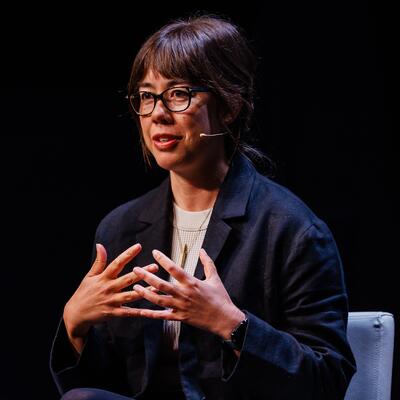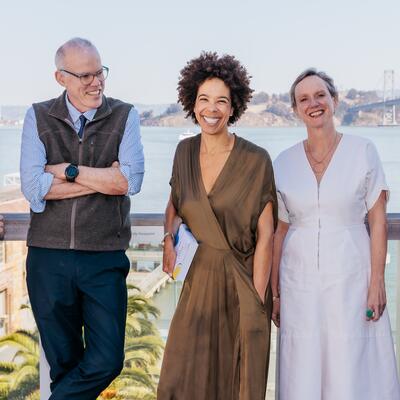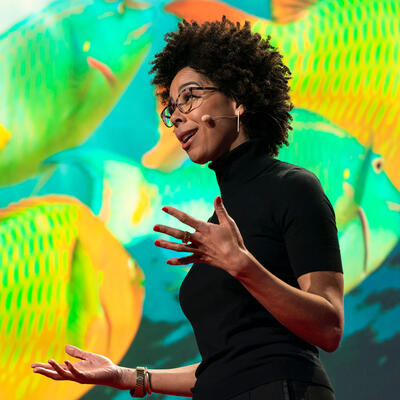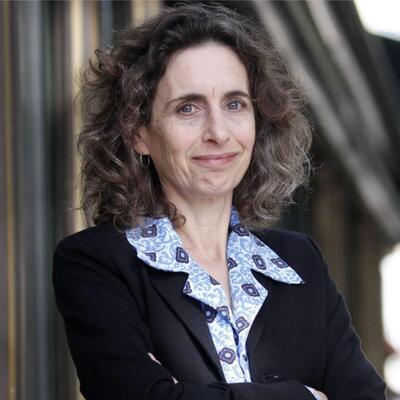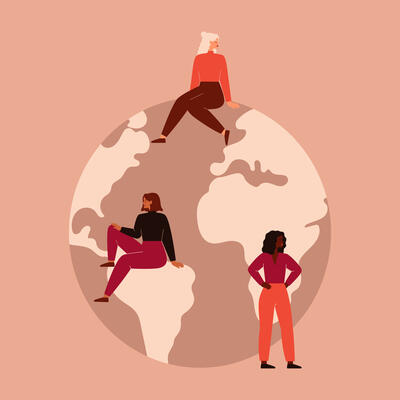
Three Big Thinkers With No Room for Doom
Guests
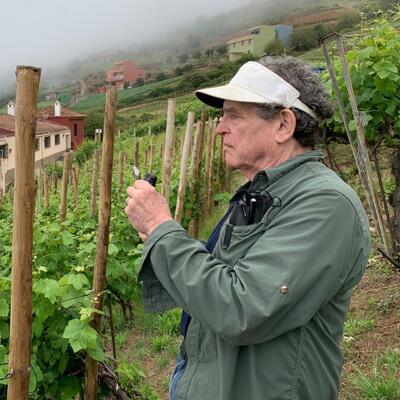
Alan Weisman
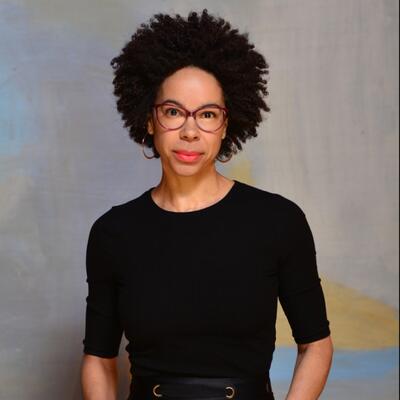
Ayana Elizabeth Johnson
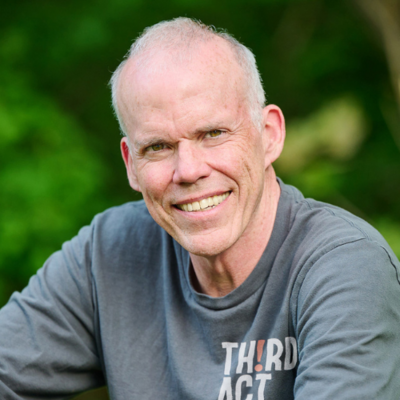
Bill McKibben
Summary
There’s so much hard and heavy news out there right now, climate related and not. It feels like decades of progress is being lost.
“We can easily picture the climate change fueled fires, floods, droughts, and storms, and the immense suffering, all of which are now well underway. However, when it comes to better outcomes, we've largely been left hanging,” says marine biologist and author Ayana Elizabeth Johnson.
But there are many solutions that can be deployed right now. Some are tried and true – like wind and solar energy — and others are being developed to play a big role in the future.
In his new book “Hope Dies Last,” award-winning environmental journalist Alan Weisman traveled the world to find people working to address and problem-solve individual aspects of the climate crisis. “ I had to realistically look at these attempted technological solutions because some of them could, if not solve everything magically, at least they can help,” says Alan Weisman.
“Scientists have been working at fusion energy even more than ever before,” says Weisman. “There's about six teams around the world right now that are racing to come up with a viable way of being able to trap the star, tap its energy, without the system destabilizing.” He continues, “You have to realize that we are already living in a sci-fi world.”
Marine biologist and policy expert Ayana Elizabeth Johnson points out, “We already have most of the climate solutions we need, heaps of them. Moving forward requires that we propel each other, propel our species, out of a phenomenally entrenched procrastination.”
To do that, she says, “We need something firm to aim for, something with love and joy in it. And we need the gumption that emerges from an effervescent sense of possibility.”
Johnson says that there is so much that needs doing, but “if you pick something you're really good at but makes you miserable, A, no one's going to want to collaborate with you… and you'll probably burn out.”
Bill McKibben has written several influential books and co-founded the international grassroots climate organization 350.org. More recently, he started Third Act, which activates seniors in the climate movement — you may have heard of “the rocking chair rebellion.” But long before any of that, back in 1989, McKibben wrote a book called “The End of Nature.” It was the first big, mainstream book on climate change. Despite the warning, we burned fossil fuels at unprecedented levels. “We've put more CO2 in the atmosphere since 1989 than in all of human history before,” says McKibben.
Even though climate trend lines are dire, we have made some amazing progress. “We live on a planet where the cheapest way to make power is to point a sheet of glass at the sun,” says McKibben. He also recognizes that people his age have the power to affect change, “If you have reached the age where you have hair coming out your ears, you probably have structural power.”
Episode Highlights
2:49 - Alan Weisman on permafrost farts
6:24 - Alan Weisman on fusion
14:11 - Alan Weisman on living in a sci-fi world
18:45 - Alan Weisman on the Netherlands
26:04 - Ayana Elizabeth Johnson on her trip to the Arctic and the feelings it created
33:40 - Ayana Elizabeth Johnson on: what if we get it right?
36:50 - Bill McKibben on what we’ve known since 1989
48:20 - Bill McKibben on using systemic power
What Can I Do?
Connect with 350.org in your area
Resources From This Episode (3)
Full Transcript
Note: Transcripts are generated using a combination of automated software and human transcribers and may contain errors. Please check the actual audio before quoting it.Ariana Brocious: I’m Ariana Brocious.
Kousha Navidar: I’m Kousha Navidar
Ariana Brocious: And this is Climate One.
[music change]
Ariana Brocious: There’s so much hard and heavy news out there right now. Climate related and otherwise. It feels like we’re losing decades of progress — and losing momentum when we actually need to be full speed ahead in making the climate crisis less bad. I think of myself a fairly optimistic person, but I’ll be honest, it’s hard to see light amidst the dark.
Kousha Navidar: Yeah, hope’s a tricky thing. Ironically, a think lot of people agree that need to have hope when things seem to be at their worst. But there’s this other phrase I’ve heard that I love – that the most cynical people are actually former optimists who have been disappointed. I think hope is a choice, but sometimes it’s a hard choice.
Ariana Brocious: That’s why I like the idea of optimism more, it’s active and tethered to reality.
Kousha Navidar: You mean like: seeing how cheap renewable energy is, or the growth rate of grid scale batteries gives you a reason to be optimistic?
Ariana Brocious: Exactly. And so to counter some of that dark news, today we’re featuring conversations with three big thinkers who maintain hope and optimism in the face of the climate crisis.
Kousha Navidar: Their idea is: we have a bunch of problems, but also a bunch solutions. And to me that’s dare I say, hopeful.
Ariana Brocious: Or optimistic… Later in the show we’ll hear from marine biologist and all around climate rock star Ayana Elizabeth Johnson.
Kousha Navidar: And, who I would call the classic climate rock star: Bill Mckibben!
Ariana Brocious: Yeah, he’s the OG! But first, my conversation with award-winning environmental journalist and author Alan Weisman.
Kousha Navidar: Some of our listeners might know him as the author of “The World Without Us.”
Ariana Brocious: And for full disclosure: Weisman was a journalism professor of mine back in undergrad. So it was really neat to reconnect and hear about his current book, Hope Dies Last. For this book, Weisman traveled the world to find people working to address and problem-solve individual aspects of the climate crisis. He offers portraits of some of our best solutions for producing carbon-free energy, sustainable agriculture, defending coastlines and restoring biodiversity. And childish as it may seem, I had to start by asking him about a phenomenon known as permafrost farts…
Alan Weisman: They started noticing a few years back that there were large holes that were developing in Siberia and there were lots of questions as to what were causing these things. There were no meteor strikes that had registered on any seismic devices. Something though was definitely happening. And finally they sent researchers up there and, One that descended into, it's, I think on the Yamal Peninsula. They descended into a crater and did some testing and saw that there was something like 53,000 times the amount of normal atmospheric methane. And so what they realized is, permafrost is reacting to a warmer arctic region. As the permafrost melts, a lot of it is just peat, which is one of our biggest natural methane producers. And suddenly all this
Ariana Brocious: And carbon sinks, I mean, by contrast. Yeah.
Alan Weisman: Yeah. But all this methane starts to just release itself to the atmosphere. And these are some phenomenal figures. Methane does not stay up in the atmosphere as long as CO2 does, uh, maybe on an average of 20 years, but as an insulating factor, you know, is something like 80 times that of carbon dioxide and you know, that's gonna be serious, but there was another discovery that didn't have anything to do with permafrost at all. It was noticed in an area of Russia's Taymyr Peninsula that there were also elevated methane spikes. In fact, they were pretty huge. They were forming these big arcs and they were going, they were about nearly 400 miles long, I think 375 miles long. And after a while these things merged. Uh, this was a couple of geologists from the University of Bonn that was tracking them and because there's no permafrost up there. Their hypothesis, and nobody has challenged this yet, is that the limestone in the region, that. It has had methane basically frozen in all its cracks and fissures. and there's been a lot of rainfall up there. So their conjecture is that all this frozen methane is coming out of limestone bedrock, and there's much more of that exposed out there than there even is permafrost.
Ariana Brocious: Right. So. A key aspect of addressing climate change and reducing or limiting the layer of greenhouse gases we've been putting into the atmosphere is to find a non-carbon emitting way to power our society. In one chapter, you trace the development of what's considered by many to be sort of the holy grail of energy production: fusion. This can yield extraordinary amounts of power without any long lasting radioactive waste, and it has kind of seemed to be forever out of reach. So where does development of that stand today?
Alan Weisman: Well, it's been researched over and over again for, a good 75 years now, So scientists have been working at fusion energy even more than ever before, there's about six teams around the world right now that are racing to come up with a viable way of being able to trap the star, tap its energy, without the system destabilizing. And that means putting a lot of energy into gas, hydrogen gas, so much that you strip away the electrons and you form something called plasma. Uh. We have to contain it in such a way that it doesn't touch anything because super heated plasma, if it touches, say the wall of a container will just cool down and then a reaction won't take place. So the way to do that is to surround it by incredibly powerful magnets that will basically hold it in place. In France, nations have been collaborating on a huge device called a tokamak, which would be, it's like a donut shaped device, and it would have magnets all around this hollow donut. And the inside would be the plasma gas.
Ariana Brocious: Right. What I'm curious about is that, that there's this been, this progression. It feels like there's been accomplishments, they've made successes, they've kind of solved all these different technological issues and yet it still feels like it is far away. Where do you think we really are in terms of achieving an actual fusion reactor that, that we could rely on?
Alan Weisman: Well, They are currently building a plant about 70 miles away from where I'm sitting here in Western Massachusetts. It's scheduled for this year, 2025, so they're gonna have that thing done and they're gonna turn it on, and I hope to be there watching to see what happens. All the indications are that they've got a really good chance of being successful. If it is successful, then they go up to building the actual plant that would be a commercial plant. Now, what's important about their plant is that they've designed it to pretty much fit the footprint of uh, or even be a little smaller than a typical coal fired plant. So this could replace a coal fired plant connect up to the same transmission lines. It would not involve any new kind of infrastructure, and the state of Virginia has already signed a contract with them. So they've already got a commercial client for this thing. Virginia is betting on this.
Ariana Brocious: Well that's exciting. That's very exciting. So I'm gonna pivot a little bit to another key challenge facing us, which is basically the issue of nitrogen. And I'm speaking about fertilizer in this case. And the challenge of trying to feed a growing population on the planet and also not poison our waterways and, um, other systems with nitrogen runoff in exchange. So In one chapter of your book, we meet Molly John, who's a plant breeding genius who saved the delicata squash from mildew. And she's trying to help in this shift away from getting conventional agriculture away from so much heavy use of fertilizer. She's currently working on a DARPA funded project that's exploring different methods of creating food from bacteria and microbes. And this was totally new to me, and I'm curious where you see this fitting in terms of solutions for our climate threatened future.
Alan Weisman: Well, you know, when I set out to do this book, I was looking at what our realistic hopes are the reality, and it's the reality of that Molly John ended up looking at, was that the Department of Defense is one of the most powerful entities on this planet. And it's DARPA, you know, it's the Defense Advance Research Projects Agency. They are always thinking about 50 years in advance and trying to figure out what are the security concerns going to be? What will we need in order to be able to maintain ourselves alive and, you know, possibly in power or at least not threatened in the future. And more and more they have been looking at the climate. So you're talking about feeding, in this case, war fighters out there in the field, and the idea of this like a platoon of soldiers really fit, uh, soldiers who are out in, uh, the middle of the desert and they're out there for a month and to maintain their fitness, they need 3,600 calories a day. How can they create that food? Right? They're on the spot. That's the challenge that Molly John came up with, uh, you know, for her contractors. But in her mind, you know, if you can do it for a platoon of soldiers and then the next step would be able to do it for a group of refugees, uh, who were found that needed food fast eventually. How could we do it for the whole human race? Uh, she thinks that we have to move from agriculture to what she calls ubiquiculture, which means that any kitchen could become a farm.
Ariana Brocious: As I read and understand, this food is essentially made through a, a reaction between bacteria, the air microbes, et cetera, and you end up with something that could be a smoothie, could be a protein bar.
Alan Weisman: You're coming in there with some fermented microbes. I mean, think of your, you know, yogurt starter, for
Ariana Brocious: It is just, it is just yogurt and sauerkraut are gonna, that's the future.
Alan Weisman: Yeah. It, well, except, except their idea is to go much beyond, the taste that we are familiar with, with kimchi or whatever.
Ariana Brocious: And I don't mean to be dismissive. I think the research is really exciting and interesting. I think it's also a measure of, you know, where we're finding ourselves that some of these ideas feel kind of sci-fi, like, you know, eating food from a machine that is just sort of drawing it from the air. Another solution that you explore in the book is, is looking on conventional agriculture using a different fermented microbial product called Proven. That is, it's kind of a similar process, but it's taking atmospheric nitrogen, pulling that down and making it into food for plants. And so as a result, farmers can apply far less conventional fertilizer and they're actually in some cases getting better yields as well. And so it's been tested across the corn and soy belt here in the US and farmers seem to be a pretty big fan. So it's an exciting technology. Also you write that in order to really almost eliminate the need for additional artificial fertilizer, we'd have to do some genetic modification to the crops. And that's yet again, kind of another step down this tech solution road, right?
Alan Weisman: Well, I think you have to realize that we are already living in a sci-fi world. And we have been since, you know, since right after World War I, just before World War I two German scientists, Fritz Haber and Carl Bosch created what's known as the Haber-Bosch process. It's the most influential invention in the history of humanity, and not too many people have heard of it, but what it is is a way of pulling nitrogen, you know, which is this nutrient that all plants need and, and yet the amount that's in soil is limited to what a few microbes, can process atmospheric nitrogen. That pretty much limited the amount of plant life on earth until Haber and Bosch figured a way to pull nitrogen out of the atmosphere. There's a lot of it. It's like 72% of our atmosphere and chemically slather it on the ground, and suddenly we could grow, you know, much more plant life than ever before. So we applied it to our grain crops and suddenly our food supply exploded and so did our population, and now we're stuck with being basically addicted to chemical nitrogen. The problem with the Haber-Bosch process is that it's very energy intensive. It uses a lot of fossil fuels. And then, when that fertilizer breaks down in the field, it creates terrible runoff that goes into our waterways and goes up into the atmosphere. Uh, it forms nitrous oxide, one of the three big perpetrators of global warming out there. The Idea of Proven is to try to make our grains nitrogen fixers by coating these corn kernels with this fermented microbial brew that a company called Pivot Bio has come up with. And when those grains sprout in the ground, the microbes will colonize the roots of these things and they will act very much like a soybean plant. It's contributing a lot of nitrogen to the plant, which means that farmers are able to cut down on the amount of nitrogen that they have to buy, Look, I don't really trust the idea that technology can get us out of the mess that technology has gotten us into. But for several chapters in Hope Dies Last. I had to realistically look at these attempted technological solutions because some of them could, if not solve everything magically. I doubt that that will happen. At least they can help.
Kousha Navidar:: We’ll hear the rest of Ariana’s conversation with author Alan Wiseman after the break. Plus, how marine biologist Ayana Elizabeth Johnson suggests we address the climate crisis.
Ayana Elizabeth Johnson: We already have most of the climate solutions we need, heaps of them. Moving forward requires that we propel each other, propel our species, out of a phenomenally entrenched procrastination.
Kousha Navidar: That’s up next, when Climate One continues.
Ariana Brocious: Help others find our show by leaving us a review or rating. Thanks for your support!
This is Climate One. I’m Ariana Brocious.
Let’s get back to my conversation with environmental journalist and author Alan Weisman.
There's a really interesting chapter in Hope Dies Last about the Dutch, and the way that they have over centuries really figured out systems for managing flood waters. Because they've invested so much in their own defenses after a really horrific flood, in 1953, I think you write no Dutch person has since perished in a flood. and yet we're now entering a new era with higher levels of sea water and so forth. So can you talk a bit about how the Dutch have navigated this and what lessons they can offer the rest of the world in terms of managing something as real as, higher seas and, and floods.
Alan Weisman: The Netherlands is the drain of Europe. It's where its biggest rivers. the Rhine and the Meuse and tributaries all pour out to the North Sea, and so two thirds of the country is a delta. And over centuries, they have reclaimed land from the sea, by creating these dikes and then polders, you know, the windmills that we're all familiar with, those were used basically to pump water. It was like turning buckets around in, in a big wheel, uh, to give them more farmland. And they've been extremely successful. , they've learned since that big flood in 1953 to create some amazing defenses. And I went to see them all. I mean, they've got one, it literally looks like the Eiffel Tower cut in half and lying, you know, on the ground. And they can swing the two sides together. And because they're on a floating pontoon and then that fills with water and that sinks to the bottom. And it forms a storm surge barrier when sensors they have out in the North Sea, you know, let them know that something bad is gonna blow in.and then they've learned how to manage the rivers to allow them to flood when they are going to exceed their banks, and to manage those flood waters in such a way that, you know, if anybody loses their crops or whatever because the river was gonna rise and they needed to let it flood, then they are indemnified for it. You know, it's an elegant system in a country that has grown very wealthy. And the reason they've grown very wealthy is that they are this seaport, And the most profitable merchandise that goes through that seaport is fossil fuels. And so the Netherlands, in a sense have been, financing their climate defenses with the very thing that is causing climatic damage. But that said, they've become so good at what they're doing that the rest of the world now hires them. You know, Katrina, New Orleans, hire them New York after Sandy, they hire them. Indonesia is trying to protect what's left to Jakarta after it sinks, with help from the Dutch and I went to Bangladesh. Which is a country four times the size of the Netherlands, and it's basically the same situation. Two thirds of it is a delta, And you know what's very ironic is that the Dutch think that they can help Bangladesh defend itself, but it's gonna cost a lot of money. Bangladesh, you know, has to become an upper middle class country to afford this whole plan that's gonna take the rest of the century to implement. And so to do that, they're building coal fire plants to jumpstart their economy as fast as possible.
Ariana Brocious: Oh my gosh.
Alan Weisman: Yeah. once again, you can do things with technology, but eventually the inputs into that technology are gonna end up coming back to bite you
Ariana Brocious: your 2007 book, the World Without Us is a long exploration of the question, if humanity vanished from the earth tomorrow, how long would it take the planet to recover?
Your new book, Hope Dies Last is a collection of all these different stories of visionaries all around the world, working to address the challenges that we're facing on so many levels. So where do you come down on, uh, humanity's future,
Alan Weisman: Well, you know, I did not write The World Without Us because I want a world without human beings. I, I, I happen to, like, my species a great deal. I'm married to a fellow homo sapiens. Um, I was hoping by theoretically removing us from the landscape and then showing how quickly nature would recover because it's breathtaking how fast nature invades when we're not looking. Ask any homeowner, but. If they saw how quickly nature could heal itself and restore and even, you know, refill some of the niches that we have inadvertently emptied, I was hoping that readers would say, wow, that's so beautiful. Is there a way that we can add ourselves back into this mix? Only in a much more harmonious, rather than combative relationship with the rest of nature and in Hope Dies Last, which I wrote, you know, it's coming out almost not quite 20 years later, we see ourselves in even a more difficult situation than we were in 2007. We've added almost a billion and a half people, and we've added a lot more carbon dioxide to the atmosphere. That quilt above our heads, invisible as it may be, is getting thicker. And yet all these people are still trying to do what I hope we can do, because I'm not ready to see my species go extinct yet. But you know, one way or another, the planet's gonna be fine. I'm not worried about the planet. It has come through worse disasters, you know, five major extinction events. You know, those are worse disasters than the one that we are perpetrating right now. Some of them have eliminated close to 98% of all the species on earth and the earth always comes back much more beautiful than ever before because life is this mysterious and very resilient quality. I just hope that we can be around to enjoy it for a little while more ourselves.
Ariana Brocious: Me too. Alan Weisman is a journalist and author of Hope Dies Last: Visionary People Across the World Fighting to Find us a Future. Alan, it's been a pleasure. Thank you for joining us on Climate One.
Alan Weisman: Thank you, Ari. I really appreciate it.
Kousha Navidar: In spite of how dire things feel right now, and - they do feel dire - there’s a ton of innovation, and maybe even transformation that is possible. There’s a lot we can do if we can just get going. And that’s really the subject of the book “What if We Get it Right?” by Ayana Elizabeth Johnson.
Johnson is a marine biologist, policy expert, and co-founder of the All We Can Save project. Last year Ariana Brocious talked with Ayana Elizabeth Johnson on the Climate One stage. Johnson had recently returned from a trip to the Arctic.
Ariana Brocious: On LinkedIn, you wrote how incredibly beautiful it was and how the experience let you fall even more in love with our planet, but you had to hold that wonder while also knowing and watching, you know, the glaciers fall apart. This is something I think a lot of us are struggling to balance with our own beloved places. So how do you suggest we balance those feelings?
Ayana Elizabeth Johnson: Hmm. That's funny. I have been asked a few times lately what, if there's something I wish I had studied to better equip me for being a useful person in this moment, and I just keep thinking psychology, right? So much of this is about how we deal with change or resist it, um, what motivates us, what makes us freeze up, um, and that's just not my area of expertise. I far be it from me to tell other people how to manage their emotions. Um, but I think the gift is that there can be endless beauty amidst the chaos and destruction. And some of that beauty comes from how we, um, look out for each other. The way we care for each other is like, so heartwarming can be. Um, and walruses, have you ever seen a walrus? and it was just, you know, such a treat to be there. And then of course, you're looking at this ice and the colors of the blues, the turquoise, that like royal blue. I've never seen anything like that, even in the Caribbean. Um, but then you're looking at, you know, these glaciers and the guide says, Oh, those used to connect and now they're two miles apart. And the Arctic could be ice free within a decade in the summers, just a completely different ecosystem, right? And currents will change and food webs will change and all of this, and so obviously change is the constant and just embracing that. I mean, I think yeah. I'm known for advocating for finding joy in climate action. And I think it's important to allow that to be small things, not like a constant skipping giddiness, but like appreciating beauty and love and all of it whenever it appears.
Ariana Brocious: Yes, absolutely. well, you fell in love with coral reefs at age five.
Ayana Elizabeth Johnson: I love a love seque.
Ariana Brocious: and you, you put in your book that it's just as, as coral reefs were dying, but perhaps the same could be said of a five year old today because they're still dying. so there's this term shifting baselines that kind of captures that what we experience as normal or, or static really isn't. Things change, and then we kind of come to think that they aren't what they used to be and so forth. I'm not explaining it that well.
Ayana Elizabeth Johnson: coined by Professor Daniel Pauly, the most cited fisheries biologist in the world, someone I really, really look up to. And yes, it's this idea that whatever, you know, You first saw an ecosystem as you assume that's the baseline, even though it probably was much more resplendent in the past. And so basically we have like lowered expectations
Ariana Brocious: and they continue, right? They continue as we continue to change those places. So how have you witnessed that and your own shifting baselines in your
Ayana Elizabeth Johnson: My mom's like, that's not a lot of insects. I'm like, there's so many bugs in the garden. She was like, no, She's like, you're in denial too. So I think it's so important to have these multigenerational relationships, collaborations when it comes to climate work. I know Bill McKibben's coming up here soon, but I'm just so enamored with the work Third Act is doing , making sure elders collaborating with young folks in the movement.
Ariana Brocious: Yeah, we'll talk about that shortly. You write that 70% of Americans are worried about climate change. Most don't even talk about it with their friends and family, though. And the 11% of Americans, 37 million people who are willing to become actively engaged, haven't taken action. That's a big number of people and climate can feel lots of things, right? It can feel daunting, overwhelming, scary, but you've created a Venn diagram to help people understand where they can find their climate action. So for those who are not in the room with us, can you describe the, these three overlapping circles and, you know, how they work?
Ayana Elizabeth Johnson: I love a Venn diagram. So the first circle is, what are you good at? So what are your skills, your resources, your networks? What can you specifically bring to the table? And this is a reaction essentially to the environmental movement from my perspective for many years, giving everyone a very similar and generic list of things we should all do, right? Vote, protest, donate, spread the word, lower your own carbon footprint, which is, of course, you know, a term popularized by Ogilvy on behalf of BP. So thanks. And what a, what a loss if we're all just doing the same things. Please do those things, by the way, like I do them. We should all be doing them. And yet we need to bring our special magic, our superpowers into the mix too. so what are you good at? , And I think it's worth saying we should be very generous with ourselves about that category. Like, are you really good at planning parties? That would be helpful. Do you make good websites? We need those. Are you just like an incredible project manager? Great. We need that too. This is not about like engineering per se, right? Or only politics. So what work needs doing? There are hundreds, if not millions of climate and justice solutions. So , I recommend people check out Project Drawdown for a list if you need some inspiration. So drawdown.org has all these different climate solutions, their relative, benefits on reducing greenhouse gas emissions, et cetera. , and then on top of that, the Drawdown review, which came after that. You can download for free on their website and is, I think, much better and clearer. Really good graphic design. I'm obsessed with good design. , and it talks about the accelerators for climate, so implementing climate solutions, right? Things like politics and culture. , So what work needs doing? Pick something. And then the third circle is what brings you joy. sources of satisfaction and delight, not this very superficial in my estimation, American pursuit of happiness. I just don't care if we're happy all the time, as long as we're being useful and kind and all these other things.
Ariana Brocious: And joy is different than happiness.
Ayana Elizabeth Johnson: It's totally different. And I would say like, if everyone could just be slightly goofier, I'd really appreciate that too. I think this whole book tour, I'm like, can we take climate change seriously, but like, please don't take ourselves seriously. Like, it's just, it's so boring. So that's my pitch. Take it or leave it. But what brings you joy? And so finding our way to our own sort of bespoke climate action in the heart of those three circles is what I would encourage each of us to do.
Ariana Brocious: I think it's really powerful because it really does that mean the intersection of these things is what also will keep you engaged,
Ayana Elizabeth Johnson: Yeah, if you pick something you're really good at but makes you miserable, A, no one's going to want to collaborate with you, and we need to build a bigger, stronger team, and you'll probably burn out. And, you know, this is the work of our lifetimes, so please don't pick something awful to do.
Ariana Brocious: And there's plenty of work doing, needing done, right? You say that this question, what if we get it right, isn't asked enough, , why isn't it asked more? And, and what's sort of the importance in asking it?
Ayana Elizabeth Johnson: I don't know why it's not asked more. This is another like human psychology question. Maybe we gravitate towards the apocalypse
Ariana Brocious: I think that's true.
Ayana Elizabeth Johnson: I don't know. I don't know if there's any
Ariana Brocious: to envision a dark future.
Ayana Elizabeth Johnson: I think I'm just going to cheat and answer this the way I answered it in the book, if that's okay. , I would say here, , if we're honest, maybe we doubt that humanity actually can get it together, can rally the depth of motivation and creativity required to face this unprecedentedly gargantuan challenge. But one thing is certain, um, Half action in the face of potential doom is an indisputably absurd choice, especially given that we already have most of the climate solutions we need, heaps of them. Moving forward requires that we propel each other, propel our species, out of a phenomenally entrenched procrastination. We don't need more data or a more rigorous cost benefit analysis. We need action. But I get it. For decades, what scientists, writers, filmmakers, and artists have projected for us is the apocalypse in great detail. We can easily picture the climate change fueled fires, floods, droughts, and storms, and the immense suffering, all of which are now well underway. However, when it comes to better outcomes, we've largely been left hanging. That is a problem. Humans evolved to not leap into a void. That's dangerous. So we need something firm to aim for something with love and joy in it. And we need the gumption that emerges from an effervescent sense of possibility.
Ayana Elizabeth Johnson: So essentially, like, I wrote this book because it's the book I needed to read, right? Like, show me the way forward. And I came up with this title, What if we get it right visions of climate futures? And I was like, Oh, how do I answer this question? Who am I, you know, to answer a question this enormous and fundamental. And so then I, you know, called all my smartest friends to help me answer it. And instead of paraphrasing them, I let them all speak for themselves.
Ariana Brocious: Coming up, climate activist Bill McKibben discusses the power of older generations to move the needle.
Bill McKibben: If you have reached the age where you have hair coming out your ears, you probably have structural power coming out of your ears as well.
Ariana Brocious: That’s up next, when Climate One continues.
This is Climate One. I’m Ariana Brocious.
Bill McKibben is a climate legend. He’s written several influential books and co-founded the international grassroots climate organization 350.org. More recently, he started Third Act, which activates seniors in the climate movement. Last year he joined Ayana Elizabeth Johnson and me on the Climate One Stage.
We talked about McKibben’s 1989 book “The End of Nature.” It was the first mainstream book on climate change. And it raised the alarm.
Bill McKibben: In 1989, we had, I mean, the horror, actually, of this story is, we had fair warning. We knew what was coming. The scientific process worked to provide us with a clear consensus picture of what was going to unfold if we didn't stop burning coal and oil and gas. We didn't stop burning coal and oil and gas. We've put more CO2 in the atmosphere since 1989 than in all of human history before. And so now, everything that we warned about starting to happen, in fact, more than starting everything breaking over our heads. I mean, the last 18 months have seen a rapid spike in the planet's temperature, which had been ramping steadily up. But we've had the hottest days on this earth in 125,000 years, which means all of us are living on a hotter planet than anyone we would really ever recognize as a fellow human has ever lived on, and the results are miserable as one would expect. And the prospect, of course, is that it will get much worse before it gets better. That's how the physics of this is going to play out. But that's precisely why the message of this book is so important. We have, and this is the key part always to remember, a few years to make very, very dramatic changes, the biggest changes humans have made in how they organize their economies in hundreds of years, and if we don't do it, this will get much, much worse. But It's entirely possible to do it. We have, as Ayanna says, the tools that we need. We can begin to see them starting to be deployed. The question is whether or not we will do it at a pace that begins to catch up with the physics of climate change. And that in turn depends on, I think, at least in part, some of those questions of psychology that Ayanna keeps discussing.
Ayana Elizabeth Johnson: How quickly and how justly right there's different possible futures, but we just further entrench inequality and that's no good.
Bill McKibben: Absolutely. So far we've run this climate movement, which we've both played our part to help build on mostly fear and anxiety and guilt and sadness, all of which are entirely appropriate emotions and all of which have had their power. But we've probably maxed out the number of people that we can get with those and they've begun to cause often a kind of paralyzing grief and anxiety. So now we need to draw on other emotions, hope and joy and a sense of adventure, which are very real. So we're, we're, you know, California when the sun goes down at night, the biggest source of supply to the California grid is batteries that did not exist on that grid three years ago. 2024. Compared to 2023, California has used 29 percent less natural gas to generate electricity than it did last year, 29 percent a big number, a number big enough that spread around the world,
Ayana Elizabeth Johnson: It's a huge deal
Bill McKibben: Spread around the world that takes a big chunk, starts to take a chunk out of the three degrees Celsius that we're staring in the face of. But, It has to happen, this change, very fast. Because if it doesn't happen fast, then it doesn't do us much good. No one has a plan for how to freeze the Arctic back up again once it's melted.
Ariana Brocious: Right. Well, I'm sure there will be plans for that.
Ariana Brocious: Bill, you've spent a number of years or maybe really the last decade focused on money and you and Naomi Klein and others spurred a fossil fuel divestment campaign beginning in 2012. About 40 trillion. I think I have that number right in university endowment funds and pension funds have since been pulled out of fossil fuels. That's a huge number. And fossil fuels continue to be pumped and drilled and, and used and burned. So what evidence do you have that divestment is having an effect?
Bill McKibben: Well, I mean, We've made it more expensive to do this work, and there's, the coal industry can't really find much capital anymore to expand, but the oil and gas industry continues to find capital in part because the biggest banks in the world and the four biggest funders of fossil fuel on the planet are Chase City, Wells Fargo and Bank of America continue to hand out loans even though the scientific community has been absolutely clear that we cannot build more fossil fuel infrastructure. They told us to stop No more.
Ayana Elizabeth Johnson: you told me, JP Morgan Chase, Citibank, Wells Fargo and Bank of America provided about 1. 5 trillion dollars in financing to fossil fuel companies since the Paris agreement was signed, where we all agreed we should ramp down those things.
Bill McKibben: And that number's just kept going up, which is why, you know, a thousand of us went to jail this summer outside in Citibank in New York. it's unconscionable what, institutions in the name of the most short sighted, short term greed are doing. Are willing to do, they will break the planet if we don't manage to stop this quickly.
Ariana Brocious: And are you seeing, uh, there was one bank you wrote about in the interview with Ayanna in here that did make a marked change, but those four haven't to my knowledge. So I mean, are you seeing they're starting to make some changes?
Bill McKibben: The craziest part of it is, is that they've all made some noises, you know? Oh, we're going to go net zero or whatever. We'll do it someday, we'll, you know. But nobody is willing to just, uh, bite the bullet and get down to it, which is quite annoying, because, you know. I mean, one understands why, uh, Exxon are amoral, actors. They know how to do one thing in the world, drill for oil and set it on fire. But, you know, Chase Bank, this is a relatively small part of their business. They can make outsized profits doing lots of other things, including the thing that we actually need to do. Which is deploy lots of capital to build solar panels, wind turbines, and batteries as fast as ever we can.
Ariana Brocious: Well, what's holding them back?
Bill McKibben: The CEO of Exxon said his company would never invest in renewables because they don't return above average profits for our shareholders. And in that he's clearly wrong. Correct. In that, you can make plenty of money putting up solar panels, but you can't make Exxon sized money. And the reason is because once you've put them up, then the sun delivers the energy for free every morning when it rises above the horizon. You know, Exxon can't control the sun's output and store it up and sell it to us a little bit at a time. It's a great gift from the world around us that we can take advantage of, and that's spectacular news for humanity. Uh, we're at the moment when if we could seize it, we could stop burning things on planet Earth in short order. You know, not only might save the climate, but nine million people a year. One death in five on this planet comes from breathing the particulates that go and you burn fossil fuel, which we do not need to do anymore. We live on a planet where the cheapest way to make power is to point a sheet of glass at the sun. Okay, that we continue to do. That is down. Mostly Really, really entirely to the fact that the small number of people who own oil wells and coal mines refuse to part with their business model and If we can't make them do it, which is why we organize in the ways we do then we have little prospect But I think we can make them do it, or at least we can give it a good try.
Ariana Brocious: Ayanna mentioned your organization Third Act, and I want to get to that. This is aimed at activating folks over 60 in their quote unquote third act of life. For you personally, how has your approach to activism changed, in this phase of life?
Bill McKibben: Well, I mean, I, I've been at this a while, since I wrote The End of Nature when I was in my mid twenties. So, I'm now in my mid sixties. So, I, it's been a lifetime's work. And the motivations shift some. I'm gonna be dead before the very worst of this hits. so it's not anymore quite myself I'm thinking about, but as you get nearer the exit than the entrance. terms like legacy start to become less abstract. I mean, legacy is the world you leave behind for the people you love the most. We're about to be the first generations to leave behind a planet worse than the one we inherited, which no one wants. I have a, now a six month old grandchild. And that means I'm deeply in love with someone who's going to be here in the 22nd century. God willing. And, and, so that does shift how one thinks about time and the future.
Ayana Elizabeth Johnson: I have actually, um, new polling on specifically this motivation that says when advocating for climate action, love for protecting future generations is the biggest motivator, 12 times more popular than job creation or economic growth, which is great that people aren't just motivated by money and sort of like the as these executives are, but not the average person.
But I think. I used to think that I was kind of corny, like do it for love kind of thing. It's like, so, I mean, I'm like
Bill McKibben: You're a romantic, come on.
Ayana Elizabeth Johnson: but I think of like climate action as like, just, of course, we're going to try to make this better. Right. Like you don't have to get all romantic about it, but, and especially as someone without children, like it's not something that I always thought of as like my personal legacy. But I certainly do think about in terms of biophilia, right? Like my love of life and biodiversity. And of course, like, even though I don't have my own children, I love children. I would like them to live in a safe and healthy world. , and so I think this is another thing that the climate movement hasn't really tapped into is, apart from joy, uh, and adventure. And I would add creativity as exciting reasons to be involved in this, that like, we should just embrace that
Bill McKibben: people
Ayana Elizabeth Johnson: do this for love.
Ariana Brocious: and I also want to say that to me, third act, people who are in that phase of life have money and power and time. And in my mind, those are things you need to be deeply engaged and maybe you don't have to have those. And it's not a prerequisite. But I want to think that, you know, influence to people who are, who have had careers and maybe have ties. I mean, are you seeing that work?
Bill McKibben: we say, If you have reached the age where you have hair coming out your ears, you, you probably have structural power coming
Ayana Elizabeth Johnson: out of your ears. I can vouch for the ear hair since I'm on
Bill McKibben: we're, uh, uh, there's 70 million, 70 million Americans over the age of 60, 10, 000 more every day, which is more than the number of people born in this country every day. But we punch above our weight politically. Because we all vote, there is no known way to stop old people from voting. Um, and we ended up with most of the resources. So if you want to put some pressure on Washington or Wall Street or your state capital, having a few people with hairlines like mine, I mean, you know, we'd all love to have a hairline like Ayana's. You know, let's be honest. But, It's not the worst thing in the world to have some older people backing up the young people doing this work. The first time we did one of these demonstrations outside a bank, it was because young people had asked us to come join in. And they were like, we, we want to protest outside Chase, but we don't even have checking accounts. So will you come? We're like, sure. And, and, uh, we showed up and there were, you know, two or three hundred high school kids because there always are. They understand perfectly well the barrel down which they are staring. , and they're somewhat spryer. So they were in the lead of the march. But at the back there was a group of us from this nascent third act with a big banner that said, Fossils against fossil fuels. Okay, um, and we've gone on. Now we've got a hundred thousand volunteers around the country. We're good at this stuff in all kinds of ways, from getting people to vote to getting people to go to jail, and,
Ayana Elizabeth Johnson: they'll show up with their rocking chairs at
Bill McKibben: Yeah, absolutely, it's, well, we're,
Ayana Elizabeth Johnson: the stink eye.
Bill McKibben: We're a little, uh, we've reached the age when sprawling on the concrete outside Citibank for four or five hours at a time is less fun than you would once would have been. So, that's right, we went to Goodwill, we got every rocking chair we could find. The Times the next day called it the Rocking Chair Rebellion
Ariana Brocious: I love that.
Bill McKibben: So, it's, it's It's symbolic of precisely what Ayana is talking about in that Venn diagram.
Ayana Elizabeth Johnson: Another one of the interviews in this book is with Rihanna Gunn-Wright, who does incredible work on climate policy, was the one of the lead architects of writing the green New Deal resolution. And she's like, if everyone had to breathe this air. If rich white people had to breathe this air, we would have solved this problem long ago, right? It's the communities that live along the fence lines of these fossil fuel facilities that are dealing with the major burdens, health impacts of all of this. , and so yes, we'd all much rather catch photons from the sky than keep doing this crazy setting dinosaur juice on fire thing. , and I think that's, it's just, it, it just feels so ridiculous to have to say that out loud. To advocate for justice in that way, because it's just like, of course, we shouldn't be making poor people and people of color deal with all this stuff, especially given the even grosser injustice that often they're the ones that did the least to cause it all over the world.
Bill McKibben: This profoundly makes the point that none of this happens. No arm of this happens by itself. So it's always a mix of litigation and legislation and protest and lobbying. I was in Montana over the weekend. And Montana is the other state where young people have managed to win a court victory in this, and the reason they were able to is because Article 9 of the Montana State Constitution guarantees the right to a clean and healthy environment and mandates that the legislature enforce it. It surprises people when they read that Montana, now we think of as quite conservative state, has this provision. It was adopted. In the year or two after Earth Day, when, in 1970, when 20 million Americans were in the street, uh, 10 percent of the then population, the biggest demonstration we've ever had in this country. Lawyers can't do this, you know, produce magic on their own. Uh, all of this requires that we change the zeitgeist of the world in which we live, and that's what organizing is about. That's what this book is about. That's why we engage in this kind of conversation. And, and, sometimes that's why we go to jail. And, there is no exact one magic solution to what we're doing. it's going to take people who have different skills, different resources, working very much towards the same end. And because. Because the bad guys are working very much towards the same end. Profit is a deeply unifying motive that keeps them hard at work 24 7, doing what they're trying to do. Love needs to be our motive and it needs to keep us engaged. as hard at work,because the next few years will be the decisive few years.
Kousha Navidar: And that’s our show. Thanks for listening. Talking about climate can be hard, and exciting and interesting -- AND it’s critical to address the transitions we need to make in all parts of society. Please help us get people talking more about climate by giving us a rating or review. You can do it right now on your device. Or consider joining us on Patreon and supporting the show that way.
Ariana Brocious: Climate One is a production of the Commonwealth Club. Our team includes Greg Dalton, Brad Marshland, Jenny Park, Kousha Navidar, Austin Colón, Megan Biscieglia, and Ben Testani. Our theme music is by George Young. I’m Ariana Brocious.
